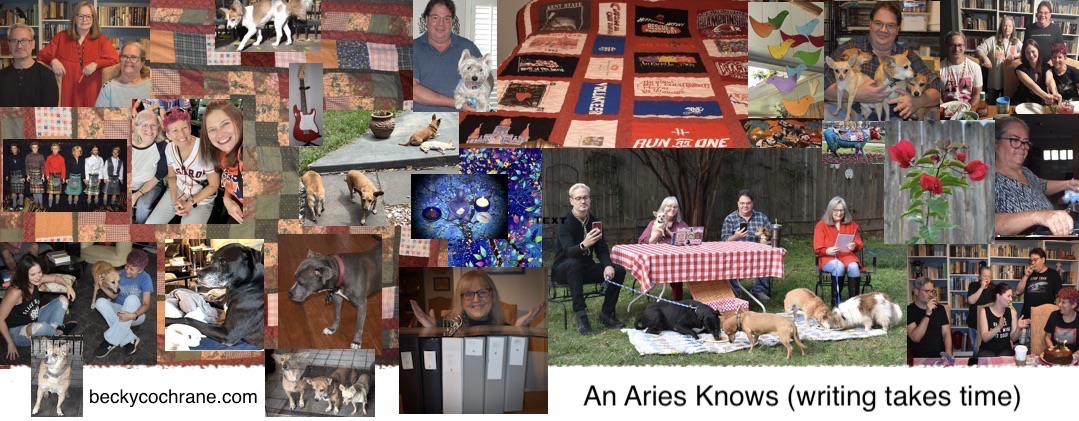
I’ve talked about dreams before on my LiveJournal. Each person has a fantastic psychological and psychic dream landscape, rich with symbols, memories, fears, hopes, people–imagined and real–and messages from their brains. But I believe this landscape is one no one else can ever really share with quite as much enthusiasm or wonder as the dreamer.
One of the more miserable experiences of my work life was knowing someone who came to me every day to tell me her dreams and ask me what they meant. Although she was a nice person, I dreaded seeing her. I did anything to avoid being alone with her. She ruined what had been a pleasant acquaintance and pretty much ended any interest I had in talking to people about dream symbolism and meaning. Because of the way she turned every conversation into a discussion of her dreams, although I occasionally share a few details of my dreams with people (and sometimes silly details of a dream on LiveJournal), I never do it without the inner knowledge that listeners or readers are most likely thinking, Why should I care? or What does this have to do with me? or Will she EVER shut up? or the farmer in the dell…the farmer in the dell…
I’m willing to occasionally hear about someone else’s dream, as long as I’m not expected to analyze it. In fact, I’ve often found that when I try to filter someone else’s dreams through my perceptions, I’m met with resentment and hostility. Because no one can really understand another person’s dreams. Your dreams are genuinely all about you, and other people don’t need to go trampling over them in heavy shoes of logic and explication.
Some people say they don’t dream. They do, but they haven’t trained their minds to remember their dreams. Maybe they have other ways of understanding their interior selves. I need my dreams. They often give me answers to questions that trouble my soul, or give me hope, and even sometimes write in my mind words and scenes that become part of my novels. I believe many creative people draw on their dreamscapes for their work.
I started thinking about all this because of an article I read about dreams and grief. I’m including the full text behind a cut in case you’re interested, along with a beautiful painting I found by artist Nancy Tuttle May of North Carolina. And finally, just to show you that I don’t take it all too seriously, here’s a bonus button.

 Majestic Dream, Nancy Tuttle May
Majestic Dream, Nancy Tuttle MayWinding Through ‘Big Dreams’ Are the Threads of Our Lives
by REBECCA CATHCART
(July 3) – I was in the fluorescent pallor of a windowless office, staring at the dense grid of an unfilled spreadsheet, when my mother called to say my father had died. It wasn’t a surprise. He had been given a diagnosis of terminal cancer the year before. But it was a jolt to my system — one switch, pulled down with a thump, the power fading and the conveyor belt coming to a stop.
My memories from that week are a jumble of misfiled pieces. But at the end of the second week, I had a dream that remains crisp and vivid in my mind.
I sat up in bed and saw my father across the room. His figure was full and healthy and framed by the yellow light that glowed in the stairwell outside my door. He was grinning, green eyes on me, and listening to sounds from the dining room below, the clinking of plates and the voices of my extended family laughing and sharing memories of him. He raised his dark eyebrows and laughed with them.
“Back to life” or “visitation” dreams, as they are known among dream specialists and psychologists, are vivid and memorable dreams of the dead. They are a particularly potent form of what Carl Jung called “big dreams,” the emotionally vibrant ones we remember for the rest of our lives.
Big dreams are once again on the minds of psychologists as part of a larger trend toward studying dreams as meaningful representations of our concerns and emotions. “Big dreams are transformative,” Roger Knudson, director of the Ph.D. program in clinical psychology at Miami University of Ohio, said in a telephone interview. The dreaming imagination does not just harvest images from remembered experience, he said. It has a “poetic creativity” that connects the dots and “deforms the given,” turning scattered memories and emotions into vivid, experiential vignettes that can help us to reflect on our lives.
Grief itself is transformative. It is a process of disassembly. The bereaved must let go of the selves they were, as well as the loved ones they have lost. The dreams we have while grieving are an important part of that process.
“Our dreams have to do with how we internalize the people we love,” said Pamela McCarthy, director of counseling services at Smith College. “You learn to look within for the loved one and the particular function that person played in your life, such as caretaking or guidance in the case of a parent. This becomes part of a function that you can provide for yourself.”
Cultural narratives in regions like Vietnam and North and South America assign special importance to such dreams and consider them actual encounters with the spirits of lost loved ones.
“This notion is so widely shared by traditions all across the globe that some scholars have gone so far as to argue that religion itself actually originated in dream experience,” Kelly Bulkeley, past president of the Association for the Study of Dreams, wrote in his book “Transforming Dreams: Learning Spiritual Lessons From the Dreams You Never Forget” (2000).
Current dream study has its epic narrative in the life and dreams of the pseudonymous Ed, a widower who recorded 22 years of dreams about Mary, his deceased wife. Ed made his journal available to G. William Domhoff, a psychology professor at the University of California, Santa Cruz, a leading dream theorist.
Dr. Domhoff and Adam Schneider, his research assistant, categorized the 143 dreams and cross-referenced them with Ed’s waking reflections on his wife, their marriage and her death from ovarian cancer on June 15, 1980. In a path-breaking study in 2004, Dr. Domhoff asserted that Ed’s dreams could not be the nonsensical noise of a restless brain stem. They represented the currents of loss, love and confusion in Ed’s waking life.
Ed and Mary’s love began on a seaside boardwalk in 1947. They wed a year later, when Ed was 25 and Mary 22. In his more comforting dreams, Mary appears young and radiant as she did that day, with dark hair and bewitching eyes.
In Ed’s dreams, his companionship with Mary and her withdrawal during an arduous illness are recurrent themes. Sometimes, his mind weaves these threads together to poignant effect, as when Ed finds himself standing across the street from where Mary sits in a car, unable to cross over.
Other times, they form jumbled, comic events. Ed and Mary are lost in a city. They see Jerry Seinfeld and ask him for directions. Soon, Ed realizes that Mary has left with Mr. Seinfeld. He broods behind a building and begins to sink in quicksand.
Almost 20 years after Mary’s death, Ed dreams he is walking down a hallway in their old apartment. It leads to Mary’s hospital room, where she lies, gaunt and still. Her head, according to Ed’s journal, is “hanging over the top edge of the bed.” Her hair is sparse, as it was after chemotherapy. “I sit on the bed,” he writes, “and cradle her in my arms.”
Such composite images and sudden scene changes, Dr. Domhoff conceded, may be the brain’s effort to make sense of random neuron fire. But they are more likely to be symbolic of Ed’s emotional struggle. Dreams, Dr. Domhoff wrote, are the “embodiment of thoughts” from our waking lives.
Deirdre Barrett, assistant professor of psychology at the Harvard Medical School and editor in chief of the journal Dreaming, wrote the first significant study on dreams of the dead. She collected dream reports from two sample groups totaling 245 people at the University of North Carolina, Chapel Hill, and found 77 such dreams. Her findings were published in the 1992 issue of Omega: The Journal of Death and Dying.
The type and intensity of these dreams, Dr. Barrett wrote, corresponded to phases of her subjects’ waking grief. She arranged the dreams in four categories based not only on common content, but also on concurrent stages of grieving.
The most common was “back to life” dreams, which made up 39 percent of the dreams of the dead in Dr. Barrett’s sample. In such dreams, subjects were surprised or frightened by the appearance of a deceased loved one. Dr. Barrett theorized that these early dreams corresponded to the confusion and denial of early stages of grief.
Dr. Domhoff is not willing to link dreams so closely to stages of waking grief. But, he said in an e-mail message, Ed’s dreams did dissipate in intensity and frequency over time.
Dreams that occur during rapid eye movement, or REM, cycles are the most memorable and emotionally powerful, said John Antrobus, a retired professor of psychology and sleep research at the City College of New York who founded the sleep laboratory there in 1965. The dreams have power because brain activity during REM is most similar to that of a waking state. The emotional responses to REM dream content, therefore, are most like the responses during waking cognition.
In REM, the amygdala, the lima-bean-size gland at the base of the skull responsible for emotions, and the hippocampus, the tissue curled up under the temples that enables memory, are active. The two organs, along with areas in the frontal and prefrontal lobes near the forehead that enable attention and coordination, work simultaneously in producing dreams.
“You have an image of a lost loved one, and along come all kinds of emotions you’ve tied up with them,” Dr. Antrobus said. “Their image comes up, and all parts of the brain associated with the loss get activated, as well in REM sleep, because they’re part of our survival system.”
In a study last year, Dr. Antrobus and City College graduate students linked the body’s circadian cycle and the singular level of brain activity in REM to the high emotionality of REM dreams.
Core body temperature rises gradually from its nadir in the middle of the night during slow-wave sleep, the least active brain state. As morning nears, subcortical brain activity tied to the circadian cycle increases. When these cycles coincide in the last and longest REM phase, the study found, the mind produces its most dramatic dreams.
“The brain is waking up,” Dr. Antrobus said in an interview. “It starts waking up long before you are fully awake.”
Dreams during this active period are more likely to be highly memorable, vivid, and experiential, what Dr. Antrobus calls “superdreams.”
“That’s what people talk about,” he said. “That’s what they’re usually remembering. That’s what these ‘big dreams’ are.”
He added that the four or five phases of REM in a normal night’s sleep might include similar dream content. Just as the image of a lost loved one stimulates parts of the brain associated with loss, the content of dreams early in the sleep cycle could set the tone for that night’s dream experiences. Our memories upon waking, therefore, may be our recollection of a night’s cumulative dream content.
Apart from an effort to understand the physiology behind the content of dreams, what do we do with big dreams? If we ignore them, said Dr. Knudson of Miami University of Ohio, “we discount our most valuable resource in understanding ourselves.”
America is not a country with a ritualistic approach to grief. Many employers offer as few as three days off after a family member’s death. Dreams of the dead keep alive our connections to lost loved ones.
“Big dreams, those dreams that stop you dead in your tracks, are for precisely that purpose,” said Dr. Knudson, whose father died three years ago. “They pull us out of our headlong rush forward. They yank us back down from our schedule books and our jobs.
He continued, “I don’t want to get over my father. That’s not to say that I want to suffer on a daily basis or that I don’t want to understand that he is dead. But I look forward to dreams in which my father will come again. What does it mean to ‘get over’ it? I think that is crazy.”
Copyright © 2007 The New York Times Company

Love the second button!!! Maybe yo should have worn one like that when you worked with this girl. LOL
I agree that only we can understand our own dreams. No one else, no matter how close we are to that person, knows everything thats going on internally with us.
That button did crack me up. After I wrote this post, I felt guilty about all the people who do talk about their dreams on LJ. I’m not criticizing that, because I think it’s valuable to explore and remember our dreams and keep records of them. Plus sometimes people’s dreams are funny (not clown funny).
I just don’t want to be put in the position again of being someone’s dream counselor, or whatever that was, because I DON’T KNOW THE ANSWERS.
Um, even though an Aries, of course, knows everything. Ahem.
You don’t?!?!? Oh My!!! I’m officially devastated… =0)
I understand exactly what you meant, Becky. I’d think others didn’t take it as a criticism, either. Whenever I share dreams with people, it’s more “isn’t his funny?” or “isn’t this weird?” rhetorically.
Where is Joseph when you need him? Love the yellow button.
Your dreams are genuinely all about you, and other people don’t need to go trampling over them in heavy shoes of logic and explication.
If that’s not a hot sentence, I give up. : )
dreams are completely fascinating to me – i have ones that i remember a LOT.
i also dream in color, which i found that not all people do. my sister usually dreams in black & white and will occasionally see a spot of color.
I find that I don’t remember my dreams unless they’re either so disturbing that they wake me up, or they’re one of my “I can’t find a clean place to pee, and I have to go really badly” dreams. That little quirk sucks a lot, actually, because it means that the only dreams I remember are the ones that wake me up in time to actually pee, or the ones that freak me the hell out.
I love Happy Bunny! That button is actually one I haven’t seen before, which means I have to have it, either in button form or magnet form or tattoo form…
That was extremely interesting.
I’m among those who don’t dream.
Well, I know that everyone does dream within the REM (?) time of sleep, but I never, ever have any memories of dreams. I was, therefore, fascinated by your sentence, “They do, but they haven’t trained their minds to remember their dreams. Maybe they have other ways of understanding their interior selves.” and I wonder now why I’ve never trained my mind to remember dreams . . . *ponders*
Well done in setting off a new train of thought . . .
My dad believed that once you reached a certain age, you stopped dreaming. However, that’s changed since my mom died. He dreams all the time. He blames his new non-smoking pills, but I think it’s great that he can remember his dreams now.
I dream all the time. A long time ago, I had issues with nightmares, so bad in fact, my parents sent me to a doctor for them. I had to go to therapy for a few years to STOP this one particular type dream from occurring. I never slept, either, which is why I think I don’t sleep well now. While it sounds very Nightmare on Elm Streetish, it was pretty close to that, but not in a bloody sense. Now, I have nightmares a few times a month, waking up screaming. It freaks Bob out. But it’s still better than what is was.
I love dreaming. I love the flying ones, too.
I dreamed of Jeannie once. And then this guy, Darren followed me around for a few weeks… totally awkward.
You’re a funny girl. =)